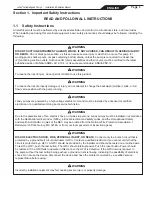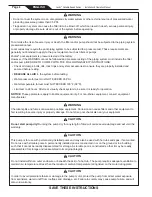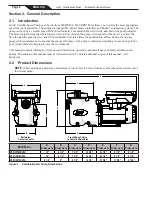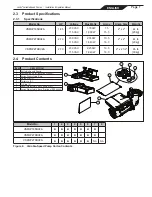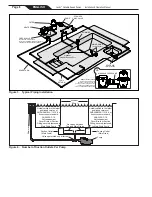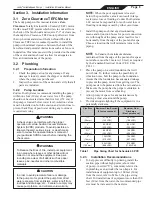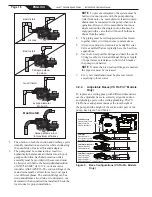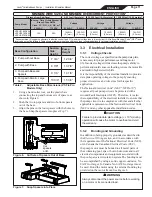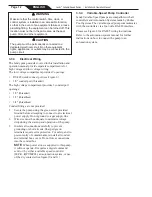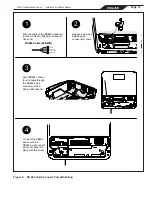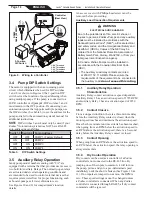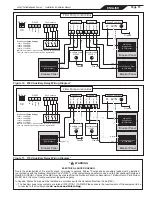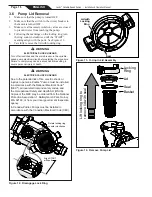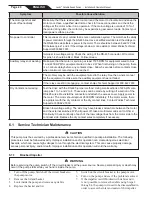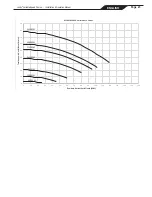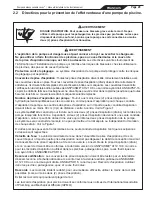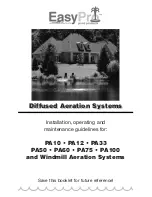
Page 17
ENGLISH
Jandy
®
Variable-Speed Pumps
|
Installation & Operation Manual
3.7 Conduct Pressure Test
WARNING
When pressure testing a system with water, air
is often trapped in the system during the filling
process. This air will compress when the system is
pressurized. Should the system fail, this trapped air
can propel debris at a high speed and cause injury.
Every effort to remove trapped air must be taken,
including opening the bleed valve on the filter and
loosening the pump basket lid while filling the pump.
WARNING
Trapped air in the system can cause the filter lid
to be blown off, which can result in death, serious
injury, or property damage. Be sure all air is properly
purged out of the system before operating. DO NOT
USE COMPRESSED AIR TO PRESSURE TEST OR
CHECK FOR LEAKS.
WARNING
ELECTRICAL SHOCK HAZARD
Do not pressure test above 35 PSI. Pressure
testing must be done by a trained pool professional.
Circulation equipment that is not tested properly
might fail, which could result in severe injury or
property damage.
WARNING
When pressure testing the system with water, it is
very important to make sure that the pump basket lid
is completely secure.
1. Fill the system with water to eliminate trapped air.
2. Pressurize the system with water to no more than
35 PSI
.
3. Close the valve to seal the water in the system.
4. Observe the system for any leaks or pressure decay.
5.
If there are lid leaks, repeat this procedure. For
Zodiac Technical Support, call 800.822.7933
Section 4. Operation
4.1 Start-up
CAUTION
Never run the pump without water. Running the
pump “dry” for any length of time can cause severe
damage to both the pump and motor and will void
the warranty.
If this is a new pool installation, make sure all piping
is clear of construction debris and has been properly
pressure tested. The filter should be checked for
proper installation, verifying that all connections and
clamps are secure according to the manufacturer’s
recommendations.
WARNING
To avoid risk of property damage, severe personal
injury or death, verify that all power is turned off
before starting this procedure.
1.
Depending on the location of the pump, do one of
the following:
•
If the pump is located below the water level of
the pool, open the filter pressure release valve to
prime the pump with water.
•
If the pump is located above the water level of
the pool, remove the lid and fill the basket with
water before starting the pump.
2. Prior to replacing the lid, check for debris around
the lid o-ring seat. Debris around the lid o-ring seat
will cause air to leak into the system and will make
it difficult to prime the pump.
3.
Hand-tighten the lid to make an air tight seal. Do
not use any tools to tighten the lid: hand-tighten
only. Make sure all valves are open and the unions
are tight. Restore power to the pump.
4.
Once all the air has left the filter, close the pressure
release valve.
The pump should prime. The time it takes to prime
will depend on the elevation and length of pipe
used on the suction supply pipe. See Installation
Recommendations in Section 3.1 for proper
elevation and pipe size.
The default priming speed is 2750 RPM. The pump
will take approximately 14-15 minutes to prime at
this priming speed when the pump is located 10 feet
above the pool water. If priming speed is adjusted
to 3450 RPM, the pump should prime within 6
minutes at 10 feet above the water level.
NOTE
The pump is NSF-certified as being able
to prime at heights up to 10 ft above the pool water
level, at sea level. However, to achieve better self-
priming, install the pump as close as possible to the
water level of the pool.
If the pump does not prime and all the instructions to this
point have been followed, check for a suction leak. If
there is no leak, repeat Steps 2 through 7.
For technical assistance, call Zodiac Technical Support
at 800.822.7933.

